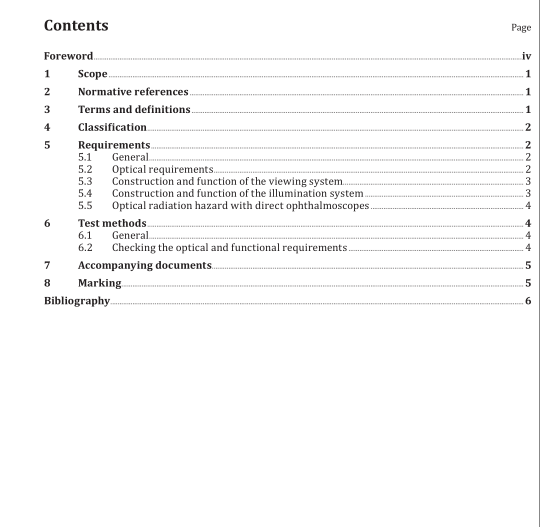ISO 10942:2022 pdf download.Ophthalmic instruments — Direct ophthalmoscopes
This document, together with ISO 15004-1 and ISO 15004-2, specifies minimum requirements and test methods for hand-held direct ophthalmoscopes designed for directly observing the eye fundus.
This document takes precedence over ISO 15004-1 and ISO 15004-2, if differences exist.
2 Normative references
The following documents are referred to in the text in such a way that some or all of their content constitutes requirements of this document. For dated references, only the edition cited applies. For undated references, the latest edition of the referenced document (including any amendments) applies.
ISO 15004-1, Ophthalmic instruments — Fundamental requirements and test methods — Part 1: General requirements applicable to all ophthalmic instruments
ISO 15004-2, Ophthalmic instruments — Fundamental requirements and test methods — Part 2: Light hazard protection
IEC 60601-1:2005+A1: 2012, Medical electrical equipment — Part 1: General requirements for basic safety and essential performance
3 Terms and definitions
For the purposes of this document, the following terms and definitions apply.
ISO and IEC maintain terminological databases for use in standardization at the following addresses:
— ISO Online browsing platform: available at https:// www .iso .org/ obp
— IEC Electropedia: available at https:// www .electropedia .org/
3.1 ophthalmoscope
optical instrument used to examine the external and internal parts of the eye, particularly the media and the fundus
3.2 direct ophthalmoscope
ophthalmoscope (3.1) which provides an illuminating system, an observation system and viewing lenses which allow the observer to visualize the patient’s eye directly, that is without the formation of an intermediate image
3.3 viewing lens
lens which is positioned between the observer’s eye(s) and the eye to be examined in order to achieve optimum focus, i.e. to correct for patient’s and/or observer’s refractive error and/or accommodation
Note 1 to entry: In direct ophthalmoscopes when a selection of such lenses is required, these are integrated with or mounted in a disc or other mechanical means by which the user can easily position the lens of choice centrally in the visual path.
5.3 Construction and function of the viewing system
5.3.1 The viewing lenses shall be arranged so that, as viewed from the observer’s side:
a) increments of positive power, indicated by black or green figures, increase when the disc is turned clockwise;
b) increments of negative power, indicated by red figures, increase when the disc is turned anticlockwise.
5.3.2 The viewing lens control shall be provided with indexing stops for each lens power.
5.3.3 Left-hand and right-hand operation of the viewing lens control shall be possible.
5.4 Construction and function of the illumination system
5.4.1 The defocused illumination beam shall be homogenous and achromatic as determined by visual inspection.
5.4.2 The minimum adjustment range of the luminous flux from the illuminating system of Group A direct ophthalmoscopes shall be from the maximum to 10 % of the maximum.
5.4.3 Group A direct ophthalmoscopes shall have a minimum of two aperture stops in the illuminating system. These shall be a full aperture and a reduced aperture. Additionally a red-free filter shall be included.
NOTE Other filters, apertures, ophtalmoscope graticules, slits or half-circles are optional.
5.5 Optical radiation hazard with direct ophthalmoscopes
This clause replaces IEC 60601-1:2005+A1: 2012, 10.4, 10.5, 10.6 and 10.7
The direct ophthalmoscope shall conform to the relevant requirements in accordance with ISO 15004-2.
6 Test methods
6.1 General
All tests described in this document are type tests.
6.2 Checking the optical and functional requirements
6.2.1 The requirements specified in 5.2 shall be verified by the use of measuring devices with accuracy better than 10 % of the smallest value to be determined.
Measurements shall be carried out according to general rules of statistical evaluation.
For measuring the refractive power according to Table 2, a focimeter as specified in ISO 8598-1 should be used.
6.2.2 For measuring the field of view, place the direct ophthalmoscope so that the back surface of the instrument is 12 mm in front of a pin-hole illuminated by a non-collimated light source.
6.2.3 The requirements described in 5.3 and 5.4.1 shall be checked by observation.
It is essential that the divergent angle of the light source exceed the minimum angle of field of view specified in Table 1.
Project the light patch onto a screen at a distance l (expressed in millimetres) from the pin-hole (see Figure 1). Measure the diameter d (expressed in millimetres) of the fully illuminated, central core of the patch, disregarding the penumbra rim.
For the purposes of this measurement, use a 0,2 mm diameter pin-hole and calculate the angle of field of view, φ, from Formula (1):
d is the diameter, expressed in millimetres, of the fully illuminated, central core of the patch,disregarding the penumbra rim;
l is the distance, expressed in millimetres, from the pin-hole to the screen.ISO 10942 pdf download.ISO 10942 pdf download
